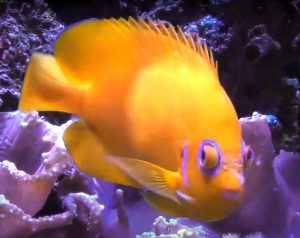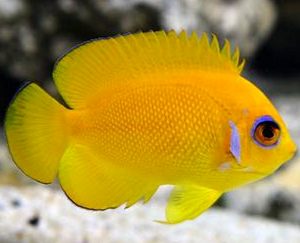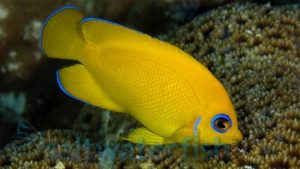The Lemonpeel Angelfish (Centropyge flavissimus) Marshall Islands
The Lemonpeel Angelfish (Centropyge flavissimus) known to tropical fish keeping enthusiasts as the Dwarf Lemonpeel Angel is found throughout Indo-Pacific oceans however, specimens have been reported inhabiting the reefs in Kaneohe Bay off Oahu, Hawaii as well as off the coast of Florida. They are not endemic to the Hawaiian Islands or Florida and their presence is thought to be due to illegal releases of unwanted aquarium residents into these inshore waters.
The Lemonpeel Angelfish has a uniform yellow body color with a blue ring around the eyes and dark blue accents around the gills and edges of the dorsal, ventral, and caudal fins. Juvenile Lemonpeel Angelfish have a large black eyespot on the side that is often edged with blue.
All angelfish are born as females and as they grow the larger, the most dominant fish will transform into a male. Should the male die, the next in line in the hierarchy will become a male.
Keeping several juvenile specimens together is the best way to obtain a mated pair. It usually takes about two to three months for females turn and pair up. Watch for aggressiveness during this time period.
Lemonpeel Angelfish are often confused with Herald’s Angelfish (Centropyge heralde) which have a yellow to yellow/orange body color and lack the blue accents around the eyes and fin edges.
Lemonpeel Angelfish are an aggressive, omnivorous species that are best kept separate from other angelfish when housed in an aquarium environment. They do well with other reef fish but should be closely monitored when initially introduced.
Although it’s best not to keep Lemonpeel Angelfish with fish of the same genera; they can be introduced as juveniles into an aquarium of significant size with a large amount of live rock to create enough grazing areas for each dwarf angel to stake out their own territory.
Although Centropyge flavissimus can be initially housed in a 30 gallon tank, they are best kept in an aged aquarium of at least 55 gallon capacity or larger; especially if you are keeping a mated pair or a trio of this species. An “aged aquarium” should be at least 6 months old to provide all the necessary algae required to feed your angelfish.
They do best in a typical reef setting with a large amount of live rock arranged into shelters and hiding places. Large amounts of live rock will provide enough grazing area for microalgae growth which is necessary to maintain the health of the fish, but because they are constant grazers, Lemon Peel Angelfish will eat away at some of the reef structure and are NOT considered reef safe. You should expect soft corals, stony polyp corals, sessile invertebrates, and clam mantles to be slowly destroyed by Lemonpeel angelfish over time.
Water quality is essential to all marine residents, so regulator water changes are mandatory. In an aquarium of 55 to 65 gallon capacity, a 10% to 15% bi weekly water change is recommended. In an aquarium over 100 gallons, a 20% monthly water change would be considered normal maintenance. Because Lemonpeel angelfish are constant grazers, water changes should NOT include scrubbing algae off of the interior of the aquarium.
Lemonpeel Angelfish are pelagic (egg scatterers) and although they are extremely difficult to breed, they have been bred in an aquarium environment.
They require a deep tank, stable lighting, warm pristine water quality, and sufficient food for the emerging larvae. Centropyge flavissimus need a water temperature of 79 to 83 degrees F for 14 to 16 hours a day and at least a 20 inch deep tank to allow room for their spawning ritual.
Lemonpeel Angelfish reproduce by external fertilization. They perform a “dancing” ritual and release their eggs and sperm simultaneously at dusk. As they dance, they rise up into the water column and release their eggs and sperm near the surface of the water. This spawning behavior can be encouraged by artificially simulating the natural dusk light cycle.
The eggs fall to the bottom where they hatch in just under 24 hours. After hatching, the small larvae require microscopic algae within 24 to 36 hours for their minute mouths. Because raising the fry is so difficult, a great deal of prior preparation is required to adequately feed them. The larvae will only eat certain kinds of live foods. They will not eat rotifers and baby brine shrimp are to large for them to eat, however, they may eat copepods
.
Lemonpeel Angelfish are algae grazers that in an aquarium environment require a diet of Spirulina, marine algae, mysis, brine or frozen shrimp, high quality angelfish preparations, and other meaty items. They should be given 3 small daily feedings.
Because the Lemonpeel Angelfish requires more algae and seaweed in its diet than most other angelfish; substantial amounts of live rock are needed in the tank to provide enough beneficial macro algae growth for the fish to graze on.
Lemonpeel Angelfish (Centropyge flavissimus) are relatively common in the hobby and tropical fish keeping enthusiasts can obtain them from fish shops, importers, online auction sites, and a variety of online retail sources at reasonable prices.
Minimum Tank Size: 55 gallons
Aquarium Type: Not Reef Compatible
Care Level: Moderate
Temperament: Semi-aggressive
Aquarium Hardiness: Hardy
Water Conditions: 72-80°F, 8 to 12 dGH , pH 8.1 – 8.4, sg 1.020-1.025
Max. Size: 5.5″
Color Form: Yellow, Blue
Diet: Omnivore
Compatibility: Single species
Origin: Indo-Pacific oceans
Family: Pomacanthidae
Lifespan: 11 years
Aquarist Experience Level: Advanced





2 Responses to “Lemonpeel Angelfish (Centropyge flavissimus)”
Trackbacks/Pingbacks
[…] lack the blue ring around the eye and dark blue accents around the gills and fins that Lemonpeel Angelfish (Centropyge flavissimus) […]
[…] from females. Because Half Black Angelfish are well known for cross breeding with Eibli and Lemonpeel angelfish, some beautiful and interesting hybrids are occasionally seen in the […]